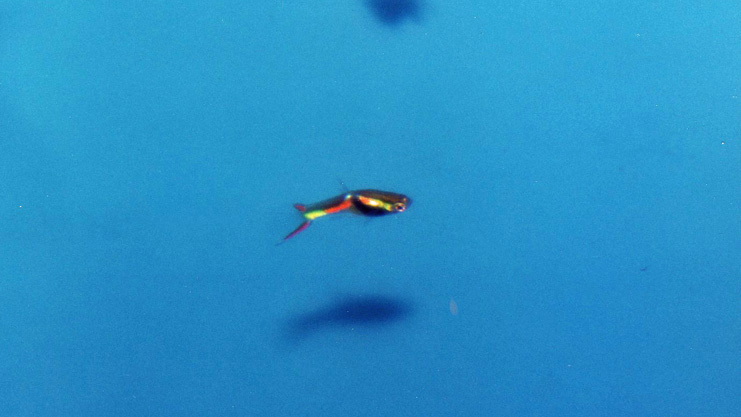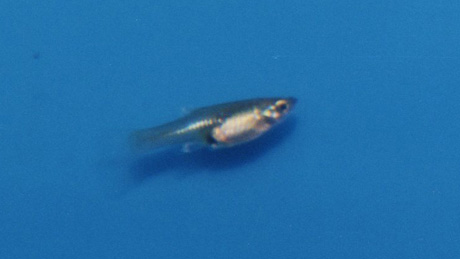Endler's Livebearer
Poecilia sp.

By Tony Griffitts and Dr. John A. Endler
Published - 1997, Revised:
Even today (1997), with all the fish I have seen in the aquarium hobby in the last 29 years, there occasionally comes along a fish that totally draws me to a tank and makes me gaze with wonder and say, "What is it!" In this case, it looks like a guppy, it's about the size of a guppy, but the bright color and the pattern of the fish are something I have never seen before in a guppy. As I look at the fish some more, I notice the females even look a little different than any female guppy I have ever seen before. The male is only about ¾ of an inch to seven-eighths of an inch (about 2 cm). The color is what is so eye-catching. The male fish has orange, black, yellow-green, and baby blue. The female's color is a little different from the guppy, as it seems to be a slight golden silver, but this may vary slightly depending on the diet.

Endlers are very lively and fascinating to watch. When the male courts the female, he spreads his tail as wide as he can to make an impressive display. These fish are very prolific. While guppies will produce fry about every 28 days, Endler's will only take 23 or 24 days between broods. Endlers will eat their own newborn fry. Fry that is less than an hour old are easy prey, therefore you should keep Endlers in a heavily planted aquarium to provide hiding places for the newborn until they are able to adjust to their surroundings.
To achieve optimal growth, you should feed your Endler fry newly hatched brine shrimp. Male Endlers will begin showing color at 17 days old and will have most of their color by the time they are 22 days old. Female Endlers can have their first brood by the time they are two months old. The brood can range from as few as 4 to 6 for a small female to over 20 for a large female. If you keep two males with a few females, the dominant male will often chase the other male. Females also will, on occasion, show aggression towards other Endlers, but no harm will ever come of it. Endlers only live about a year on average, but some may live as long as two years.

When purchasing Endlers, I recommend that you buy at least 3 pairs to get a breeding colony started. I feed my Endler's flake food, frozen brine shrimp, my beef heart mix, and processed freeze-dried krill. Endlers will eat algae and are good for keeping algae off of live plants.
Because of the small size of the Endler's livebearer, they make an excellent fish for the popular small 2-gallon desktop aquarium for the office. Consider yourself lucky if you ever get the chance to own some of these gems, as they are a very rare find in the aquarium hobby.
Prof. John A. Endler collected this Poecilia sp. "Endler's" in 1975 in Laguna de Los Patos, Cumana, in northeastern Venezuela. He didn't know at the time that they were also collected in the 1930s by the fish collector Franklyn F. Bond. Dr. Endler found these fish in warm (27° C or 81° F), hard water, which is very green with unicellular algae. It coexisted with regular guppies, which are also native to northeastern Venezuela, but they were less common in places where "Endler's livebearer" is found; guppies prefer clear cooler (25° C or 77° F) and shaded streams to ponds.
Dr. Endler gave a stock of Poecilia sp. "Endler's" to Dr. Donn Eric Rosen, the then Curator of Ichthyology at the American Museum of Natural History, who was going to name it (but died a few years later). Dr. Rosen gave some of the stock to a mutual friend of Dr. Endler, Dr. Klaus Kallman, then of the New York Aquarium, and a famous fish geneticist. Dr. Kallman then introduced it to the German aquarium community. Dr. Kallman didn't tell Dr. Endler at the time, but he gave it the name "Endler's Livebearer" or "Endler's Guppy." From the German aquarists, it spread throughout Europe and Dr. Endler didn't hear about it until about 1980 when an English colleague asked him about the "Endler's Livebearer." From Europe, it spread to America, Japan, and elsewhere.
From photographs Dr. Endler has seen in a Japanese guppy book, he says it has clearly been hybridized with regular guppies (the original population did hybridize at a very low rate in the laboratory), and has lost the variation for black pectoral fins (only present in about 20% of the original population), much of the "gold leaf inlay" color pattern, and has less of an angular pointed shape of its body and fins (and more like a guppy) than the original stock.
Dr. Endler is not working with the Endler's Livebearer anymore, mainly because regular guppies provide more extensive populations to study genetics and evolution. Dr. Endler says that the "Endler's Livebearer" is its own species, not a guppy (Poecilia reticulata), and will be named soon by a German taxonomist.
Laguna de Patos is a lagoon, which is a lake formed from what used to be a brackish lake behind a sand bar and is now fresh because it gets freshwater runoff. The runoff gradually replaced the saltwater. Laguna de Patos is the only known place where Poecilia sp. "Endler's" exists, or use to exist. The fish is likely endangered, if not extinct, in the wild, due to the fact that a city garbage dump was built next to the lagoon.
Dr. Endler believes there may be a possible second site where the Peninsula de Paria joins the mainland. He had looked for the site where Peninsula de Paria joins the mainland, but was not able to find where they were supposed to exist. It was a tangle of dirt roads and the directions he had were not good enough. Maybe someone will find them someday.